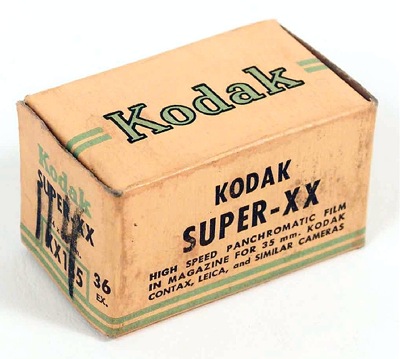 [In this five-part Guest Post, military historian Charles Herrick pursues further the questions raised by conflicts between Capa’s own account (in Slightly Out of Focus) of his D-Day return trip from the Easy Red sector of Omaha Beach to the USS Samuel Chase (APA-26), which would take him and his films back to England.
[In this five-part Guest Post, military historian Charles Herrick pursues further the questions raised by conflicts between Capa’s own account (in Slightly Out of Focus) of his D-Day return trip from the Easy Red sector of Omaha Beach to the USS Samuel Chase (APA-26), which would take him and his films back to England.
Part 3 appears below. Click here for Part 1, here for Part 2, here for Part 4, and here for Part 5. — A.D.C.]
•
Leaving Omaha Beach:
Robert Capa Aboard LCI(L)-94 (3)
•
The Other Option
… Let’s reexamine our data points. We have sound physical, photographic, or documentary evidence to support each of our five benchmarks. What we do not have is a shred of independent evidence to determine when Capa boarded LCI(L)-94. All we have are Capa’s claims (in both Charles Wertenbaker’s interview and Capa’s own Slightly Out of Focus) that he waited till the medics had gotten off the ship before boarding. But that actually leaves us two possible times.
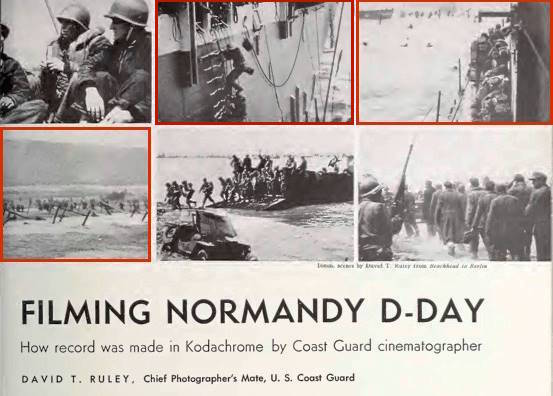
Fig. 8: Cinematographer David T. Ruley, illustrations for first-person account of D-Day experiences, Movie Makers magazine, 6/1/45
In the preceding paragraphs I alluded to the ship’s second beaching. This is a reference to USCG cinematographer David T. Ruley’s article in Movie Makers magazine, discussed in previous posts. In that article Ruley revealed that LCI(L)-94 actually beached twice. According to his first-hand account, after about half the troops had disembarked at the first site, the tide had swept the stern of the ship toward a mined obstacle, so the captain backed the ship off the beach and brought it back in about a hundred yards farther to the east, where the remainder of the troops debarked.
•
Ruley’s account of two beachings for LCI(L)-94 is further confirmed by Lt(jg) Coit Hendley’s account of the LCI flotilla’s ships on D-Day:
The story of the LCI (L) 94 was much the same as that of the other two ships of her wave. On her first beaching she managed to disembark approximately 100 of her troops under light artillery fire and the ubiquitous machine gun fire.[1]
The rising tide was pushing the ship into a thicket of mined stakes. The ship backed off and went about 100 yards to the west to try again. Going into the beach this second time, the ship ran over a ramp type obstacle that was not topped by mines and two rows of hedgehog obstacles. The remainder of the troops were put ashore.[2]
The only discrepancy between Ruley’s and Hendley’s accounts has to do with whether the ship moved east or west for its second beaching, and we have photographic evidence to solve this. A photo taken by Lt. Gislason (Figure 2) showed the ship beached at its second site, while one of Ruley’s film clips (discussed later) shows it beached at the first site. A close examination of the obstacles and tanks proves the second beaching site (as seen in Gislason’s photos) was indeed 75-100 yards farther east — coincidentally, virtually the identical spot at which Capa had stepped ashore.
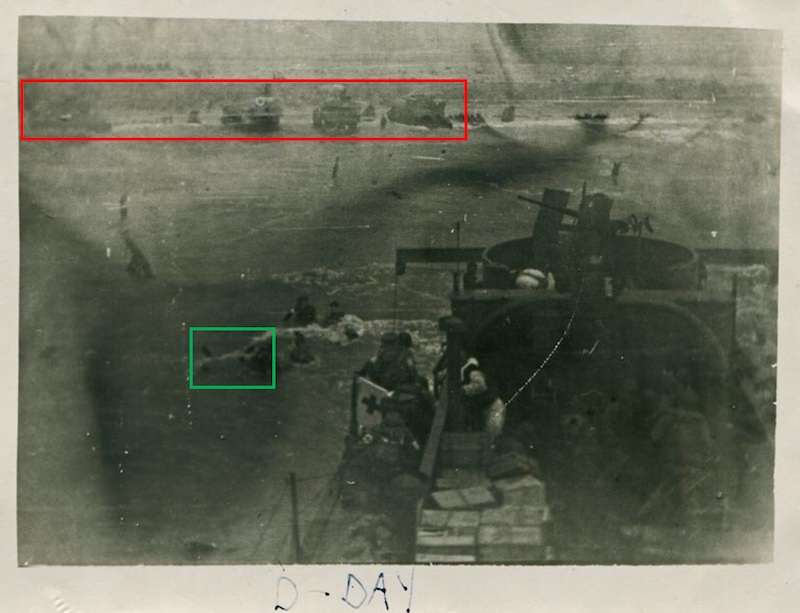
Figure 2. This photo shows LCI(L)-94 during its second beaching. The soldiers just off the port landing ramp are in water up to their shoulders. Capa, a short man, would have been covered at least as much as these men. This picture was snapped by Lt. Gislason, the ship’s captain, and donated to the National WWII Museum by the family of Charles Jarreau, a crewman of the ship.
•
So now we have two boarding possibilities. The first section of this article definitively rules out the idea that Capa boarded at the end of the second beaching of LCI(L)-94. So, what about the alternative? What if Capa boarded at the end of that ship’s first beaching, when the flow of disembarking troops was stopped in preparation to pull up the ramps, retract, and try it again?
This alternative offers several advantages. A boarding at this juncture would see Capa entering the engine room at least 15 minutes earlier than the standard narrative allowed. Thus he would have been below decks when the shells hit, and not subjected to a rain of kapok debris. That in turn explains his dapper, kapok-free appearance in Ruley’s film.
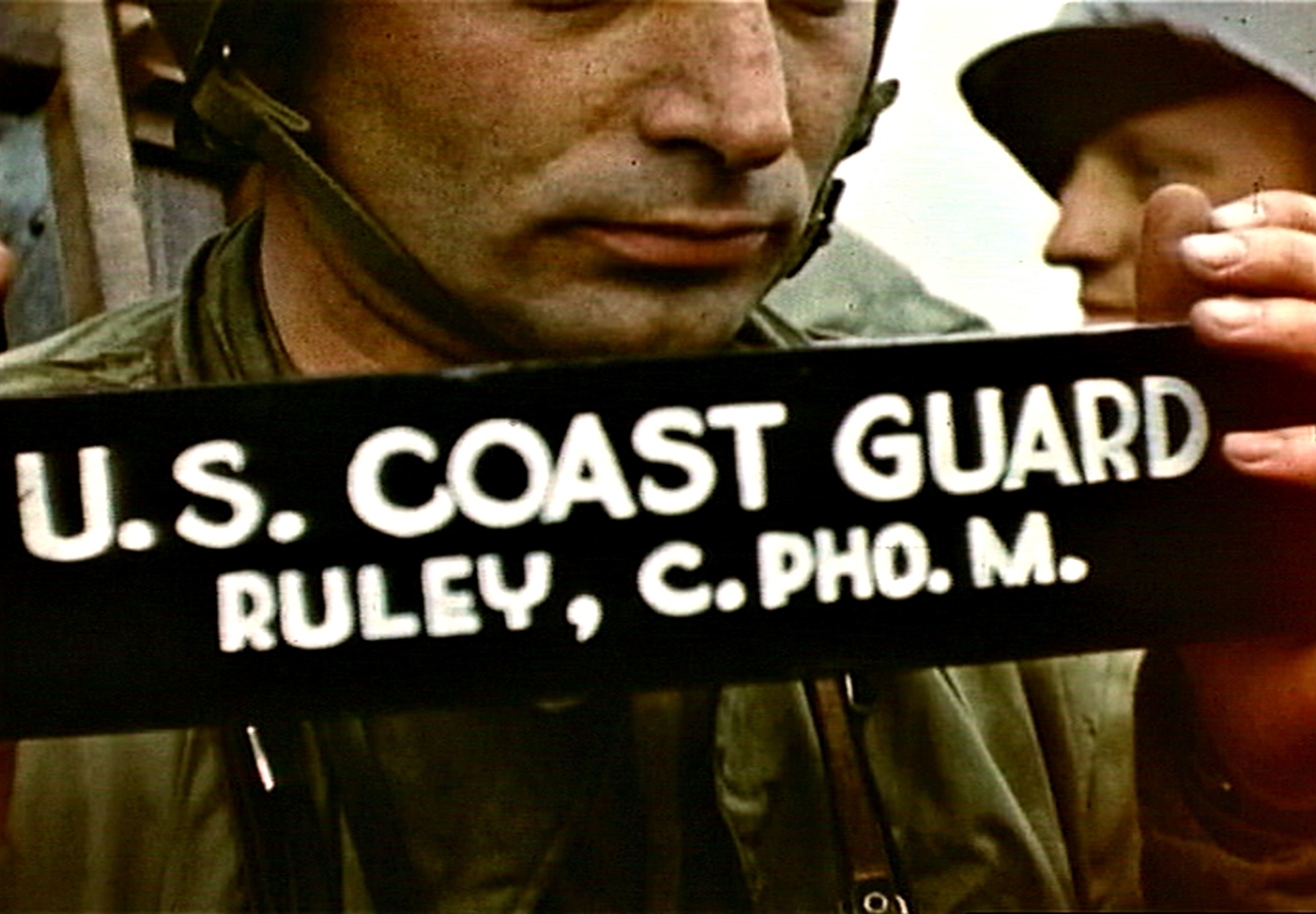
Fig. 7: Robert Capa holding cinematographer’s slate aboard LCI(L)-94, D-Day, frame from film by David T. Ruley
This earlier boarding would not, however, have spared Capa from being neck-deep in the surf as he waded to this ship and waited to board. Images from both of LCI(L)-94‘s beaching sites show soldiers near the bottom of the boarding ramps, and in both cases the men are in water up to their chests or necks. An earlier boarding time would, however, afford Capa least 15 additional minutes in which to dry off in the 120-degree temperature of the engine room[3], which would explain his dry appearance in Ruley’s film.
And this alternative makes far more sense in other respects as well. If Capa boarded then, he would have still been down in the engine room when the ship was hit. That room was two decks below and a couple bulkheads aft of where the shells impacted — on top of which, his senses would have been dulled by the roar and vibration of the ship’s eight engines. Under those conditions, if he noticed a shell hit at all (and he apparently didn’t notice at least one of them) it would have seemed very much like the “slight impact” he mentioned, rather than the violent detonation(s) that killed three and wounded three others.[4]
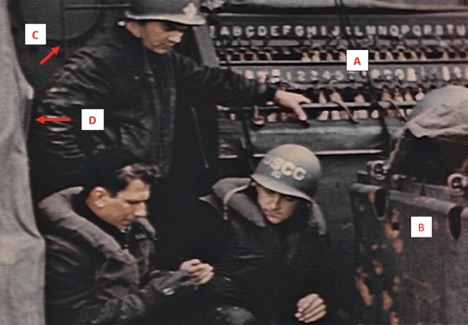
Figure 20. Three crewmen from LCI(L)-94 examine shell fragments plucked from equipment damaged by German fire on D-Day. Still from David T. Ruley film clip. (CriticalPast)
This alternative also would give him ample time to dry his hands and/or change film. More importantly, it gives him a reasonable amount of time to smoke his two cigarettes and calm his nerves before he returned back on deck to capture his two “one last shot of the beach” photos.
Capa probably wasn’t even aware that there had been two beachings. The two crewmen in the engine room with Capa weren’t aware of it. West didn’t mention it, and Lewis gave a garbled account of a single beaching and an abortive attempt to go back in to help an LCVP. Another crewman, Motor Machinist Mate 3rd Class Charles Jarreau, was in the aft steering compartment and could only stick his head through a small hatch in the deck. His view forward was blocked by the deck house and pilot house, and he gave an even more garbled account than did Lewis.[5] So if West, Lewis, and Jarreau were unaware of a second beaching, we can hardly expect the badly shaken Capa to have had better situational awareness.
So … did Capa board at the end of the first beaching? It certainly is a very attractive alternative. But does that mean he did? The answer to that largely depends on one’s interpretation of a fuzzy picture.
A Face in the Surf/A Ghost in the Image
As pointed out in an earlier post, Capa’s “Face in the Surf” photo contains an interesting detail in the upper-right corner. (Figure 8) It is a landing craft, positioned one to two hundred yards offshore. It is too large to be an LCVP or an LCM, and the profile is wrong for an LCT. But the profile is consistent with the last possible type of craft — an LCI.
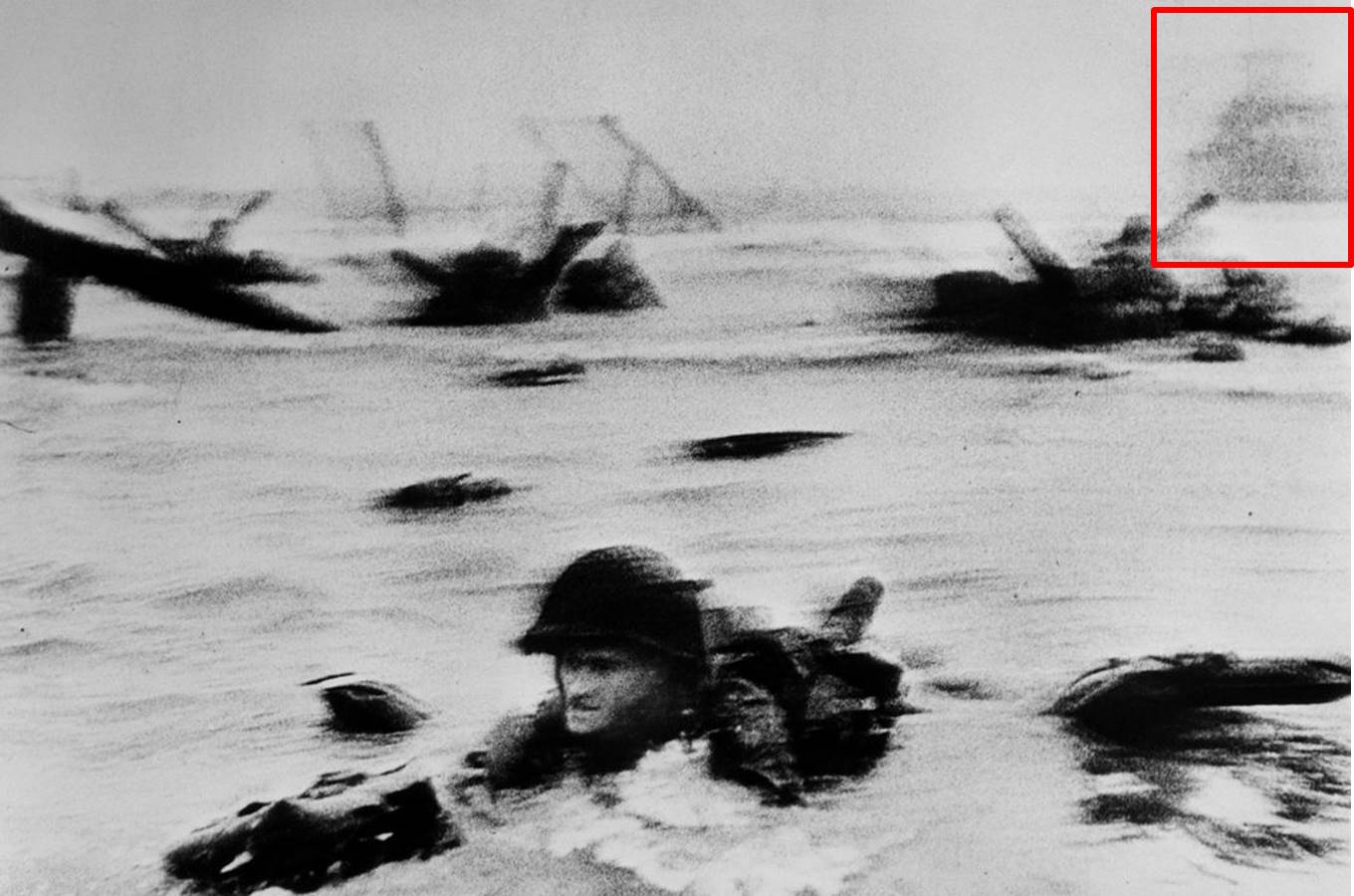
Fig. 8. Robert Capa, “The Face in the Surf,” annotated. The outline of LCI(L)-94, on which Capa returned to the USS Samuel Chase from Omaha Beach, appears in the red rectangle on the upper right.
A review of the actions of LCIs during this general period narrows it down to a single candidate: LCI(L)-94. The very ship Capa boarded when he fled the beach.
But the question then becomes this: does the photo show LCI(L)-94 already retracting after its first landing? If that is the case, then Capa could not have boarded early, and we are back trying to reconcile Capa’s narratives with irreconcilable facts. If, on the other hand, the ship is approaching for its first beaching, that makes the early-boarding alternative possible.
So which was it? Did Capa’s incoming LCVP arrive first, or did LCI(L)-94?
•
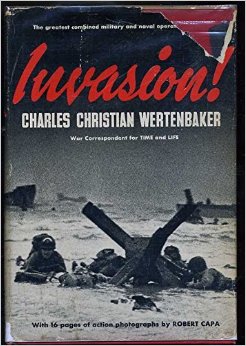
Charles Wertenbaker, “Invasion!” (1944), cover
An exhaustive analysis concluded that Capa landed in the same LCVP as Col. George Taylor, the commander of the 16th Regimental Combat Team. The regiment’s landing tables manifested Capa in the same craft as Taylor, in Wave 13. In his Wertenbaker interview, Capa said he was lowered from the USS Chase in his LCVP just before 0600 hours. According to the action report of the USS Chase (which ship carried both Taylor and Capa), Taylor’s LCVP was lowered at that same time. Slightly delayed, for reasons discussed elsewhere, Taylor landed between 0815 and 0820 hours.
And that window is not an estimate. It comes from five separate official reports, authored by men who came ashore in the pair of landing craft from the Chase that constituted that wave.[6] Capa recounted meeting the regimental chaplain and surgeon when he landed; those two men rode in the LCM that landed with Taylor’s LCVP at 0815-0820 hours.[7] And finally, an analysis of tides in Capa’s photos show that he landed at least 30 minutes after the tide state seen in the photos of Coast Guard Chief Photographer’s Mate Robert Sargent, who beached on Easy Red at 0740 hours.
As a result of the above, I’ll treat the window 0815-0820 hours as a proven data point.
•
Now let’s turn to the timeline for LCI(L)-94. There are two questions to answer here. First, why did a ship that should have landed on the Dog Red beach sector end up some 2000 yards to the east on Easy Red? Second, it was supposed to land at 0740 hours; why didn’t it?
There are several sources for the ship’s beaching time, and they seem hopelessly confusing. Lewis’s diary placed it at 0747 hours, very close to the ship’s scheduled time. Ruley placed it at 0740 hours, precisely on its schedule time. The 29th Military Police Company, which had an element aboard the ship, also reported landing at 0740 hours. Normally, this would seem fairly conclusive. But nothing dealing with Capa is normal. Why should this be different?
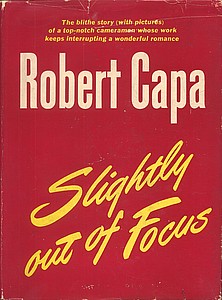
Robert Capa, “Slightly Out of Focus” (1947), cover.
The 104th Medical Battalion (the medics mentioned in Capa’s account) stated in its after action report that its men landed at 0840 hours — right in the window of the ship’s second beaching. Unfortunately, we’re missing reports from two key sources: the 112th Engineer Combat Battalion had the bulk of the troops on board the ship, but its action report is missing;[8] and there is no war diary, deck log or action report from LCI(L)-94 itself. All we have is the ship’s Muster Roll, which pegged the casualties to 0850 hours, and that time calls the 0740 hours landing into question, as it meant the ship would have spent over an hour on the beach, which is clearly unrealistic.
Fortunately, we have another pair of sources that help straighten things out. In his interview with Stephen Ambrose, Jarreau stated that the captain saw the deadly conditions on their intended beach and decided to look for a better site, which Jarreau thought they found about 350 yards down the beach.
As noted above, Jarreau was in the aft steering compartment, and not in a position to have firsthand knowledge of his captain’s decision-making. However, Jarreau and the captain were both photography enthusiasts, having set up a makeshift film developing room in the ship, so possibly during that close association Jarreau later learned of Lt. Gislason’s thought process on D-Day. Still, Jarreau’s account by itself isn’t very authoritative.
Luckily, Col. Mark Johnson provided more detail in an article about his father’s ride to the beach on LCI(L)-94 on D-Day.[9] Johnson had consulted with Albert Green when researching this article. Green was the Executive Officer (second in command) of LCI(L)-94, and it was presumably Green who provided Gislason’s reasons for diverting the ship. He stated that Lt. Gislason witnessed two LCIs — LCI(L)-91 and LCI(L)-92 — come to grief as they landed, and then decided to look for a better site to bring his ship in. Although Johnson confused the narratives of these two LCIs, the events themselves are relevant.
•
LCI(L)-91 beached on time at 0740 hours, but was still beached 20 minutes later (0800 hours) due to slow offloading. At that point it had to retract due to the proximity of mined obstacles, but detonated a mine in the effort. Though it suffered relatively few casualties and limited damage, the captain decided not to try to beach again, and tried instead to summon LCVPs to take off the remaining troops. After waiting fruitlessly for LCVPs to respond, LCI(L)-91 beached again a hundred yards down the beach. After some of the troops had disembarked, a violent explosion wreaked critical damage on the ship and started an uncontrollable fire at about 0810 hours.[10]This would have been the first sign to Lt. Gislason, loitering offshore, that the beach wasn’t a healthy place for LCIs.
While Lt. Gislason waited offshore, assessing the situation, LCI(L)-92 (slotted two waves behind him) passed and proceeded to shore. Its captain saw what had happened to LCI(L)-91 and decided to use the thick smoke from the burning ship as cover. The time it beached varied slightly among three accounts. According to the official Action Report, at 0810 hours LCI(L)-92 “passed the first row of obstacles and began to pick our way in toward the beach. The outer three rows were successfully passed, and we had what was apparently clear water to the beach. The ship was straightened out and began the run in.”[11]
Hendley’s account stated, “The LCI (L) 92 and the 84 were off their beach sector at 8:10 a.m. on time.” [12] Presumably, it would take the ship several minutes after the 0810 hours mark to negotiate its way through the obstacles before beaching. Photographer’s Mate 3d Class Seth Shepard was aboard the ship during the landing, and wrote a detailed account of his experiences several days later while in a survivors’ camp in England. He stated that at “8 AM we were less than 3 miles from land …,” which is a bit vague, but is generally consistent with a beaching window several minutes after 0810 hours.[13] I believe the captain’s time as included in his official Action Report is reliable, and the other two reports provide a degree of confirmation rare among D-Day accounts.
A few minutes later, after the ship picked its way through three rows of obstacles, straightened itself out and made its run into the beach, it hit a mine, was then struck by an 88mm shell, and finally grounded on a sandbar. The ship suffered heavy losses among the troops and quickly began burning out of control.
•
So, if Lt. Gislason didn’t decide to look for a new beaching site until he witnessed the fate of those two other LCIs, then he couldn’t have come to that decision until roughly 0815 hours (by which time, according to some reports, Capa’s LCVP had already grounded).
Having made this decision, Gislason and LCI(L)-94 had to grope their way eastward in an attempt to find a gap in the obstacles despite the rising tide and veils of smoke. His ship was 2000 yards west of its eventual beaching site, as well as probably a like distance offshore. Orders directed LCIs to sail at 10 knots in this zone, but it is unlikely that Gislason reached this speed; he was cutting across the paths of other landing craft as they headed in, and, as just mentioned, had to sail slowly enough to examine the obstacle belt closely for a gap.
The difficulty of this task is illustrated by the fact that he missed (or decided to pass by) at least two gaps before finding a site at which to beach. Once he found a suitable gap, more time would have been required to set up his approach and make the run in to shore. It’s difficult to exactly pin down how long all of this took, but it seems hardly possible that he could have accomplished all of that in less than 10 minutes. Which points to LCI(L)-94 making its first beaching on Easy Red at about 0825 hours — after Capa’s own landing.
•
These timelines seem solid, given what we know of the various actors’ movements. Capa’s landing time is validated by five separate official documents, a level of agreement extremely rare in D-Day sources. The beaching time for LCI(L)-94 is terribly confused between personal remembrances and some Army sources. However, the times of the primary events in LCI(L)-94‘s movements (the destruction of the other two LCIs) are firmly established in official Navy reports (especially the report of loss of ship, which was always given close official scrutiny), thus providing a reliable start point for the ship’s movement east along the beach. Taken in its totality, I think these two timelines argue that Capa landed first, and subsequently photographed LCI(L)-94 during its first approach to the beach. …
Notes:
[1] The Landing Tables contained in the 1st Infantry Division’s Field Order #35 (NEPTUNE) indicate that LCI(L)-94 had 179 men manifested.
[2] Hendley, p. 210.
[3] The figure 120-degree temperature in the engine room comes from the 6 June 1944 entry of Lewis’s contemporary diary.The engine room was Lewis’s station during the landing.
[4] Indeed, the slight impact he mentioned might even have been the ship hitting the ramp obstacle as it ran onto the beach the second time.
[5] Lewis’s account was contained in his contemporary diary, referenced earlier. Jarreau’s account comes from an interview that military historian Stephen Ambrose conducted with him. It was conducted five or six decades after D-Day, and many pages are missing; the result is a rambling, somewhat disconnected story, often due to Ambrose’s pursuit of tangential topics.
[6] 0815 hours was listed at the beaching time for this wave by the regimental medical detachment’s unit history, and the regimental headquarters company in both its Action Report and its Comments on Operation Neptune. 0820 hours was listed as the beaching time in the regimental headquarters company’s unit history, and more importantly, the regimental S-3 Combat Report, which served as the base document for the regiment’s Distinguished Unit Citation.
[7] In Slightly Out of Focus, Capa claimed to have encountered them at the “shingle” on the beach. If my analysis is correct, that never happened. They may have ridden in to Omaha Beach in the same LCVP.
[8] The battalion’s senior leadership and staff were killed in the landing. As a result, an after-action report may not have been submitted.
[9] Johnson, Mark, 104th Medical Battalion, 29th Division Aboard LCI(L)-94 on D-Day, US Coast Guard website (https://www.history.uscg.mil/Browse-by-Topic/Conflicts/World-War-II/D-Day-June-6-1944-Normandy/Aboard-LCI-L-94-on-D-Day/)Many of the specific landing details therein appear to have been taken directly from Lewis’s diary, including errors.
[10] LCI(L)-91 Action Report, dtd 10 June 1944, and LCI(L)-91 Loss of Ship – Report of, dated 19 June 1944.
[11] LCI(L)-92, Action Report of Recent Operations – No. France, dated 10 June 1944.
[12] Hendley, p. 212.
[13] Shepard, Seth. INVASION, The Story of the LCI (L) 92 in the Invasion of Normandy on June 6, l944. US Coast Guard Historic Documents (https://media.defense.gov/2021/Dec/15/2002909573/-1/-1/0/1944-LCI92-SETH_SHEPARD_D-DAY_ARTICLE.PDF).
•
Text copyright © 2023 by Charles Herrick. All rights reserved.
•
(For an index of links to all posts in this series, click here.)
•
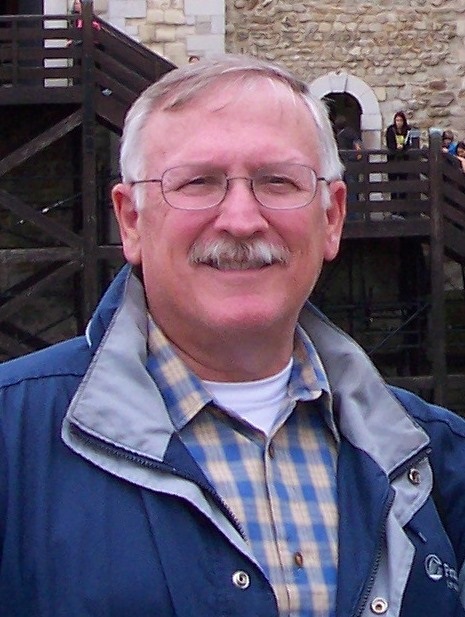 Charles Herrick joined the U.S. Army in 1970 and graduated from the U.S. Military Academy at West Point in 1974. Commissioned in the Infantry, he earned the Ranger tab and Master Parachutist’s wings. He served in a variety of positions from company grade officer to the Pentagon. He earned the Combat Infantryman’s badge while assigned as the Operations Officer of the 193rd Infantry Brigade in Panama in 1989, and later graduated from the U.S. Army War College.
Charles Herrick joined the U.S. Army in 1970 and graduated from the U.S. Military Academy at West Point in 1974. Commissioned in the Infantry, he earned the Ranger tab and Master Parachutist’s wings. He served in a variety of positions from company grade officer to the Pentagon. He earned the Combat Infantryman’s badge while assigned as the Operations Officer of the 193rd Infantry Brigade in Panama in 1989, and later graduated from the U.S. Army War College.
Since retiring from the Army in 1996, Herrick has continued to work on defense issues as a contractor in East Asia, Latin America, the Balkans, Africa and Central Asia. He holds an MBA from the University of California at Los Angeles. He lives in California with his wife, where he pursues his passion for military history. To contact Charles Herrick, click here.


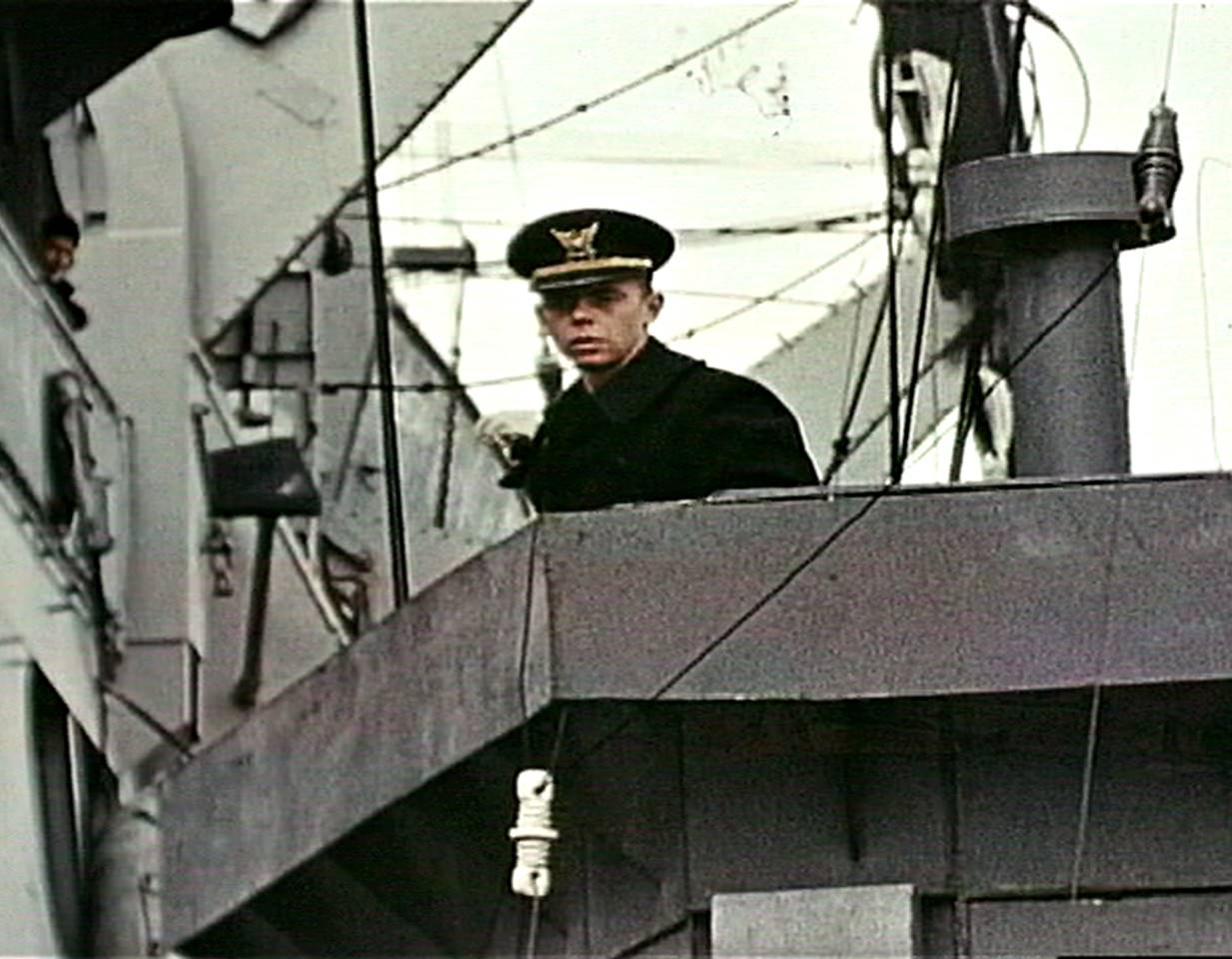




Leave a Comment